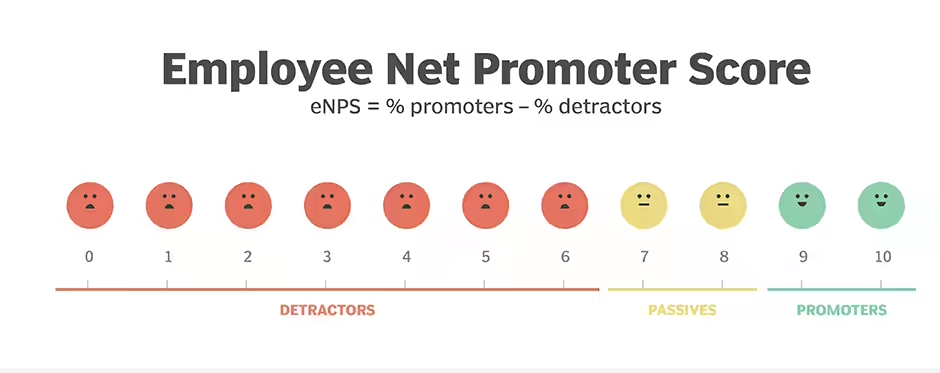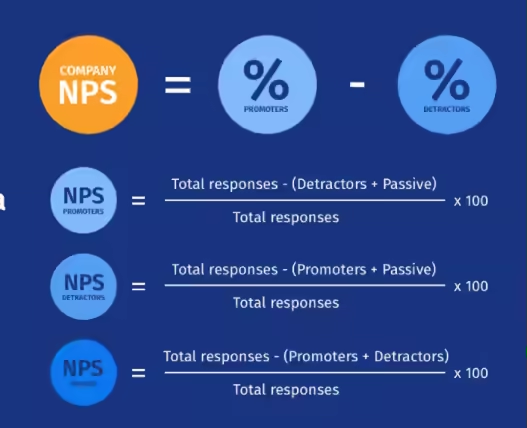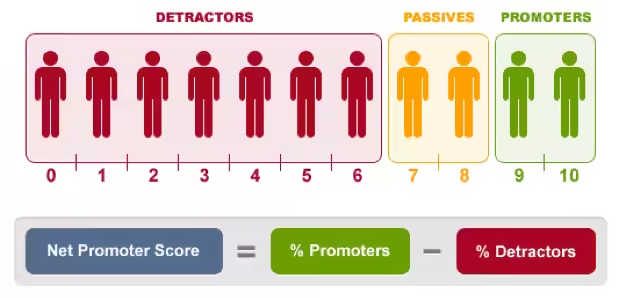The Net Promoter Score (NPS) is a metric for determining customer loyalty, contentment, and enthusiasm. Its derived by asking customers one question: "On a scale of 0 to 10, how likely are you to suggest this product/company to a friend or colleague?"
You and your organisation may employ numerous approaches and techniques to learn what your consumers think of you as a company and the services you provide. The Net Promoter Score is a number that indicates how much your customers like you and predicts whether or not they will continue to do business with you. George Kuhn states that NPS is currently a standard in customer satisfaction surveys worldwide.
Its a metric to determine how likely your employees suggest your company as a great place to work. Its derived from the Net Promoter Score (NPS), commonly utilised in customer satisfaction surveys. Companies use the same technique to assess staff engagement because it effectively measures employee loyalty.
An NPS score can be used to assess practically anything. You may measure scores for particular goods in addition to analysing your organisations overall NPS. Consider incorporating NPS into your marketing or customer service plan because it can be compared to industry NPS benchmarks. It will assist you in better understanding your target market and observing how people react to your product. The idea is to gain committed customers who will become brand ambassadors.
While most net promoter score surveys are meant to collect customer input, they can also be used to assess employee sentiment or employee net promoter score (eNPS). eNPS assesses the likelihood of your employees recommending your organisation as a place to work. Employee feedback should not be measured using eNPS, and should instead be measured using other more extensive survey methodologies such as employee engagement surveys. Because there is just one question in eNPS, it lacks the complexity of an engagement survey. Its a good place to start, but it wont provide you with a complete picture of employee engagement, and you wont know where to improve once you have the information.
Calculating the Net Promoter Score
Youll need to collect all of your respondents ratings (between 1 and 10) to calculate the Net Promoter Score. These ratings assist you in categorising your responses into the following groups:
- Promoters, or people who score 9-10 on the scale, are your most ardent supporters. Theyre a valuable addition to your companys image and recruiting efforts. Employees who are brand ambassadors for your organisation are more inclined to share job posts on LinkedIn and their networks.
- Detractors arent just uninterested in the companys prospects for success; they also have the potential to harm your brand in the long run. Such employees score between 0 to 6. Learn about their concerns and demonstrate that you genuinely care. Listening to and addressing their concerns can convert them into advocates.
- Finally, passive respondents are uninterested. They may enjoy working for you, but not enough to aggressively recommend your organisation to friends. If their feelings could be summed up in a LinkedIn status, theyd say theyre "open to opportunities" but not actively looking. Scores 7-8 are considered passive and will not be included in your final score. Understanding this groups comments can help you figure out what to do to shift them into the promoter category.

Employees rate your firm on a scale of zero (not at all likely) to ten (very likely) when asked if theyd recommend it to a friend (extremely likely). While this may seem logical, calculating eNPS is not as simple as averaging scores. Respondents are divided into three groups based on their responses: promoters, detractors, and passives. Remember that an eNPS survey must use this scale to function correctly.
Subtract your percentage of critics from your percentage of promoters once you get your survey responses. The result of this computation is your companys eNPS. Keep in mind that an eNPS might range from +100 to -100. Anything below zero, intuitively, is the reason for worry. Its worth noting that your NPS score isnt viewed as a % because youre subtracting one percentage from another.
The employee Net Promoter Score is calculated by dividing the number of promoters by the total number of responses multiplied by 100.

Good Net promoter Score
To understand what an "excellent" score level is, we must first consider two approaches to your NPS:
- Absolute NPS compares your score to scores from other industries to determine what is considered "excellent." Find out what your industrys average NPS is here.
- The relative NPS method compares your score to that of other companies in your industry. You might consider how you compare to your competitors and interpret this as a sign of successful client satisfaction.
According to Charles Schwab, the best eNPS scores are 100 and -100, respectively. However, organisations rarely achieve anything close to those levels, making them unrealistic targets for most companies. In general, excellent looks like something that is above a zero. The essential topic to consider is a decent score in your current situation. Various factors influence employees willingness to suggest your organisation as a wonderful place to work, some of which are beyond HRs control. The following is an example of a good employee net promoter score:
- An employees net promoter score (NPS) can range from -100 to 100.
- Leading firms consider a score above 0 to be good or acceptable.
- A score of more than 50 is regarded as outstanding.
- Finally, a score of more than 70 is considered revolutionary.
In the absence of other considerations such as region, industry, or profitability, eNPS survey scores differed dramatically between cultural groupings. Other things to think about are:
- Economic conditions in the region and around the world
- difference between a private and a public company
- Whether youre in the midst of a leadership transition or not
- Slow vs fast development
Employee Net Promoter Score may also be influenced by cultural variations, with scores varying by location or country and employees being less likely to offer a high score. eNPS does not always provide context-sensitive information. In light of these concerns, several experts advise against using other organisations or industries as eNPS comparisons. On the other hand, experts believe that firms should start with a score and seek to improve it. Theres a good likelihood that an organisations eNPS is lower than its NPS since employees demand more from it than consumers. This understanding can aid companies in interpreting employee Net Promoter Score.
Employee Net Promoter Score (NPS) Surveying
The eNPS is not a survey. Instead, it can be thought of as a method of measuring. Employee surveys, such as the four mentioned above, have traditionally been measured through "yes" or "no" ratings or a comment section. That gave any organisational concerns a very black-and-white perspective. As a result, it invariably presents a deceptive picture by presenting incorrect facts. An eNPS-based survey, on the other hand, ensures that an organisation can accurately capture employee thoughts.
Make your eNPS question the first question employees see if you include it in a larger employee engagement survey. You want to increase your chances of getting an accurate sense of how employees feel and specific feedback. According to a Deloitte poll, 46% of businesses plan to address the issue of employee engagement. Employee feedback is crucial for identifying organisational culture issues. Therefore HR directors and managers need to pay special attention to it.
Consider including eNPS into your pulse surveys as well. These brief surveys have one to five questions and can be repeated as needed – month after month, bi-weekly, or even once a week. While annual engagement surveys can take minutes to complete, these surveys only take seconds and provide you with a constant picture of success.
How to increase the employee net promoter score
Now that weve learned why eNPS is an excellent way to measure engagement lets look at some recommendations to help you improve your total eNPS score.
- Communicate With Your Detractors
Survey solutions like Vantage Pulse allow you to communicate with detractors anonymously about their scores. This will enable you to address their concerns while also receiving helpful comments personally. It will provide you with a clearer image of your companys flaws and even gather suggestions for how to fix them.
- Track your score
Traditional surveys have a major flaw: they are only conducted once a year and are rarely adequately assessed. You have the option of choosing a specific period, after which the survey will be repeated, with much faster and faster surveys on the market, such as employee pulse surveys. Youll have a greater chance of studying the companys engagement trends and eNPS over time if you use a regular and timely survey option. It will assist you in determining whether or not your action plans yield any results.
- Enhance Your Employee Engagement Plans
Because a low eNPS shows low engagement, it means your engagement techniques need to be improved. As a result, you must devise a concrete strategy for increasing employee happiness in your company. Look at what has worked for other businesses. Use your HR managers and senior executives to assist you. You can also ask employees directly what changes they would like to see.
- Respond to everyones feedback openly and honestly.
Once youve received your eNPS score, youll need to respond to everyones feedback and outline your next steps. If you receive negative feedback, be open and honest about the plans you have to implement. Also, provide an estimate of how long the implementation will take. Thank people for taking the time to fill out the survey and providing positive feedback. Also, convince them that you will expand on these characteristics over time to improve the employee experience.
- Examine your online image
Employees today are pretty vocal about their views. If not within their company, then definitely outside of it. Going online and seeing what others are saying about you can sometimes be the most effective way to figure out how to repair your companys flaws. Online review sites like Glassdoor and even LinkedIn may prove to be gold mines for gaining insight into why your engagement levels are declining despite your best efforts. In the same way, look at what your competitors are doing well. It will assist you in filling in the gaps and implementing the changes that employees desire to see.
Employee Net Promoter Score Calculation Benefits
The significance of eNPS cannot be overstated. The following are some of the advantages of calculating Employee Net Promoter Score:
- Helps determine total employee loyalty.
Employee Net Promoter Score is a rapid approach to assess employee satisfaction and the health of a firm, and the most significant part is that it outperforms traditional long, boring surveys. Employee loyalty is influenced by workplace culture and engagement. According to LinkedIns data, 36% of people have changed employment. As a result, by asking just one survey question, you may aid in determining employee loyalty levels. When employee loyalty scores increase, work satisfaction and engagement also increase. Conducting eNPS surveys regularly can assist management in deciding whether efforts to improve business culture are effective.
- Reduce employee attrition
Organisations will be able to prevent excessive attrition rates by measuring eNPS and other HR data and preparing a contingency plan. The results an organisation receives after distributing the eNPS survey will assist determine whether or not its employees are satisfied. As a result, corrective action can be implemented right away.
- Allows you to turn negatives into positives.
The eNPS survey can assist organisations in converting their critics into supporters. It can be accomplished by making particular adjustments to the system. An automatic system would send an email every time you received a negative answer from your staff. Gather feedback and make a point of acting on it.
- The Productivity of Employees is Boosted
You might wonder if incentivising staff to perform higher-quality work with a simple feedback approach works? Absolutely. While various elements might influence employee engagement, feeling valued is always at the top of the list.
- Problems That Have Been Hidden for a Long Time Have Been Revealed
Employee Net Promoter Score surveys are popular for various reasons, but one that is appreciated the most is their ability to pinpoint trouble spots inside the organisation. Are there any managers in particular who have disengaged teams? Are there any departments where staff appear to be dissatisfied? There are various methods to segment data in eNPS to reveal an interesting tale.
- Strong Reputation is Earned
The importance of a companys reputation goes without saying. When it comes to hiring, potential employees use sites like Glassdoor to assess how well you treat your employees. They are especially averse to working with companies that have disgruntled staff. The premise of Employee Net Promoter Score – how likely would you suggest our firm as a place to work – is that your current employees can act as semi-recruiters, inviting their smartest friends to apply?
- Innovation and ideas flow
ENPS consists of only two questions in its most basic form: an 11-point scale inquiry and an open-ended "why" question. Its critical to read every verbatim comment made in response to the surveys open-ended "why" question. Employee happiness and engagement can be improved by identifying priorities based on the responses provided. Take advantage of this valuable data and seek to improve the areas employees care about the most. You may even form a focus committee or championship squad to devise a strategy for implementing good change.
Conclusion
By no means is the Net Promoter Score a flawless tool, and it shouldnt be the only approach you employ to figure out what your consumers think about your company. When applied effectively, it can provide you with profound insights into both your organisations challenges and its strengths. As a result, it is a great tool for determining employee loyalty and satisfaction.
Nolwazi Mlala is a Business Analytics Consultant at Industrial Psychology Consultants (Pvt) Ltd, a management and human resources consulting firm.
Phone +263 4 481946-48/481950/2900276/2900966
Cell number +263 779538172
Email: nolwazi@ipcconsultants.com or visit our website at www.ipcconsultants.com

